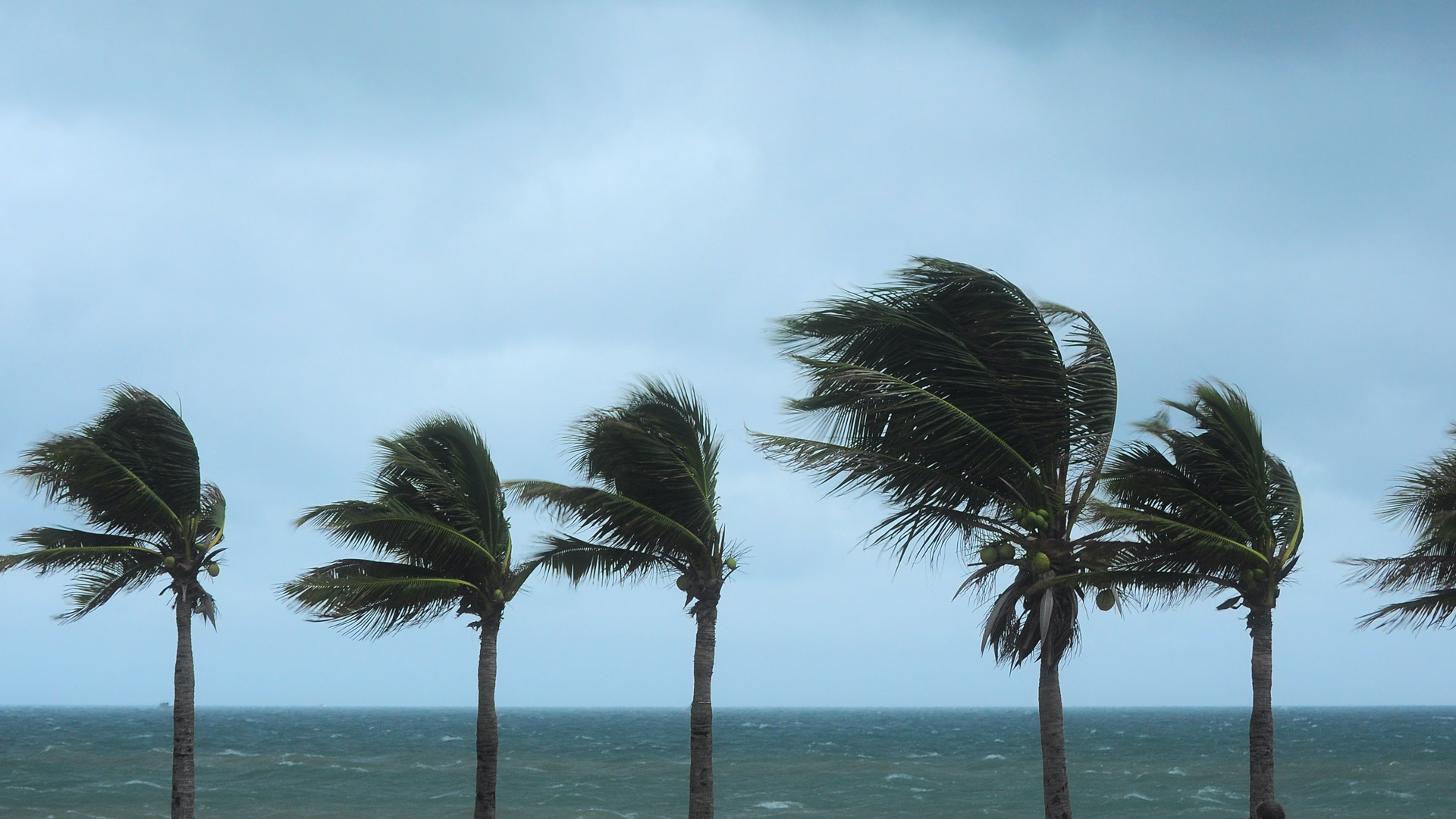GIS Professionals Are Essential to Creating a Sustainable Future
Sustainability was more than a buzzword at the 2021 Esri User Conference (Esri UC). Centering on the theme of GIS: Creating a Sustainable Future, the conference highlighted how the GIS community is confronting many of the world’s challenges and, more importantly, what else needs to be done to guarantee better outcomes than what we see on the horizon.
The theme was inspired, in part, by words that Esri president Jack Dangermond read in Why INEGI? The Saga of a Mexican Institution in Search of the Truth. The book by Mario Palma, a founder of the National Institute of Statistics and Geography (INEGI) in Mexico, stresses the importance of the organization’s role as an independent provider of statistical and geographic information in a democratic society.
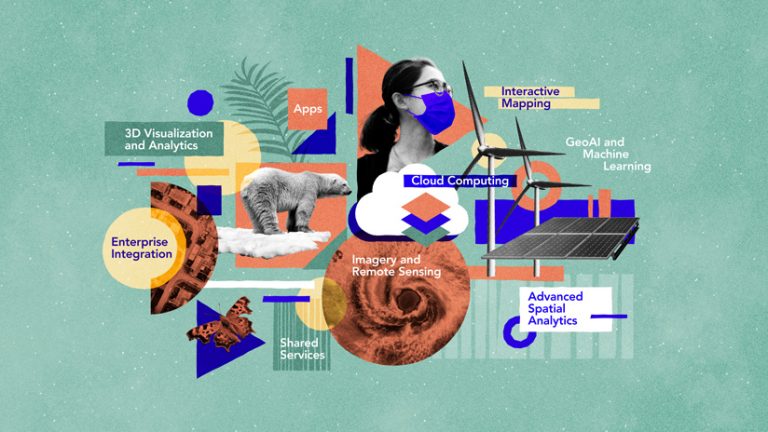
Palma wrote how the lack of understanding of reality is one of the greatest risks that every society faces and that the future depends on creating and applying understanding.
“These were the beacons that started INEGI, but these words speak to me because they are a purposeful way of describing our work [as GIS professionals]: creating and applying understanding,” Dangermond said during the Esri UC, which was held virtually for about 71,000 registered attendees July 12–15, 2021.
The world, according to Dangermond, is a complex and highly interdependent ecosystem that is undergoing rapid changes, mainly due to human activities.
“Geologists are starting to call this the Anthropocene epoch, where humans absolutely dominate the history, the life, and future of our world,” he said. “Today our world is being challenged because we, as humans, are living recklessly and unsustainably. And this is threatening our future.”
Dangermond noted some of the problems we face: pollution, severe drought, racial injustice, pandemics, human-induced climate change, and a steep decline in biodiversity. Reversing course will require creating a future that’s environmentally, economically, and equitably sustainable. This will mean saving wild lands, developing renewable energy, conserving oceans, promoting equity, improving business efficiencies, scaling back consumption, and preserving and creating green infrastructure.
“Applying our best science, our best technology, and our best creative thinking will clearly be necessary,” Dangermond said. “And…geographic thinking is going to be essential in this. Sustainability requires that we see the world as one single ecosystem. Geography provides the science and language to do this.”
Dangermond lauded the work toward these ends that users are already doing using GIS. But he noted that we need to scale up our collective efforts exponentially—and that GIS can help. Technology that supports the sustainability mission includes GIS in the cloud, advanced spatial analytics, artificial intelligence and machine learning, 3D visualization, imagery and remote sensing, and visual storytelling.
In addition, geospatial infrastructure—an expanding, interconnected network of systems, services, and apps—is making data, apps, and maps more widely available for sustainability projects, according to Dangermond.
“This is helping us collaborate. It’s helping us share,” he said. “It’s transforming workflows and decision-making at many scales.”
With the myriad sustainability issues society faces, there’s no time to waste putting forward GIS-based solutions.
“I feel like I am all in, and I want to encourage you to go all in,” Dangermond stressed. “Act with urgency.”
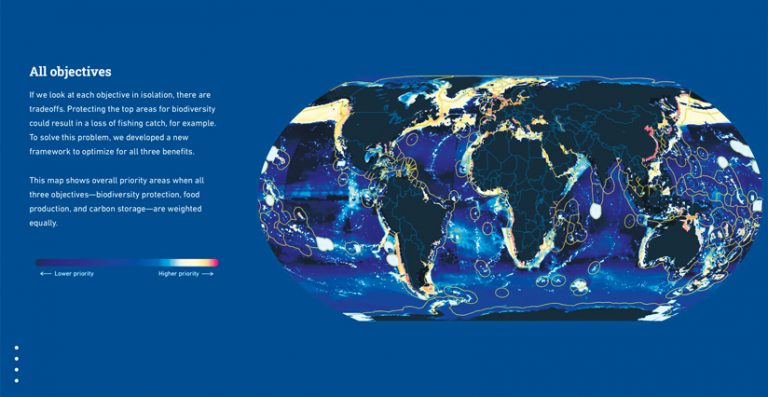
Four keynote speakers at the Esri UC outlined how they and their organizations are stepping up to advocate for and create a sustainable future. They were Wade Crowfoot, secretary of the California Natural Resources Agency (CNRA); National Geographic Explorer in Residence Enric Sala; journalist and National Geographic Explorer Paul Salopek; and La June Montgomery Tabron, chief executive officer (CEO) of the W.K. Kellogg Foundation (WKKF).
A Platform for Conserving California
Earlier this year, Esri and the CNRA entered into a collaborative agreement to build the CA Nature Geographic Information System (CA Nature GIS). According to the agency, CA Nature GIS will synthesize data and information on biodiversity, climate change, public access to recreation, and other key factors across the state of California.
During his keynote presentation, Crowfoot spoke about CA Nature GIS and its role in supporting California governor Gavin Newsom’s executive order that commits to conserving 30 percent of California’s waters and lands by 2030—known as the 30×30 goal. The platform will be used to integrate data about California’s ecosystems, places where biodiversity is rich or threatened, climate change vulnerability, and where access to nature is equitable or restricted. Local governments will use the platform’s tools to identify areas that should be prioritized for protection.
This type of scientific and data-driven geographic approach is needed to meet the 30×30 goal, according to Crowfoot.
“The challenges that we face as a planet, a nation, and a state are daunting,” he said. “Climate change in California now means a catastrophic wildfire season bearing down on us, the second straight pernicious megadrought in a decade, and extreme heat across our state that we’ve never experienced.”
Jennifer Norris, deputy secretary for biodiversity and habitat at the CNRA, joined Crowfoot and Dangermond online to preview CA Nature GIS. She said that the platform can provide a baseline assessment of the amount and location of land and coastal waters currently conserved in the state, establish a process to track progress toward the 30×30 goal, and identify areas that could be conserved.
The CA Nature GIS platform will be available to the public via a website built using ArcGIS Hub. Through it, people will be able to access mapping and visualization tools and authoritative data, giving them the ability to view and analyze information about California’s natural resources. A set of data exploration apps is also being developed, including an online app designed to explore data on biodiverse areas in California.
Dangermond asked Crowfoot how communities will be brought in to help achieve the goal of conserving 30 percent of the state’s land and water in less than a decade.
“The goal is driven from the top, but the solutions are driven from the grass roots,” Crowfoot said.
What will be helpful, he added, is that CA Nature GIS will be publicly accessible, so environmental, conservation, equity, and hunting and fishing groups can participate.
“The challenges are unprecedented, but I think the 30×30 [commitment] is a galvanizing target like none other on environmental conservation,” he said.
Nature can be restored, Crowfoot pointed out, as evidenced by the return of the California condor, the resurgence of sea otters, and the repopulation of beavers in rivers.
“This can happen and will happen if we marry the political will with scientific understanding and the technology tools,” he said.
Establishing Marine Reserves That Protect and Provide
As a professor at the Scripps Institution of Oceanography in San Diego, Sala’s life in academia was humming along. He taught students and wrote scientific journal articles that focused on the negative impact of humans, climate change, and fishing on ocean life. Then he had a revelation.
“I was publishing lots of papers with more and more data about how fast marine life was dying because of us,” said Sala during his Esri UC Keynote Address. “But one day, looking out from the ivory tower, I realized…that all I was doing was writing the obituary of the ocean. I felt like I was the doctor who was telling you how you were going to die…but not offering a cure.”
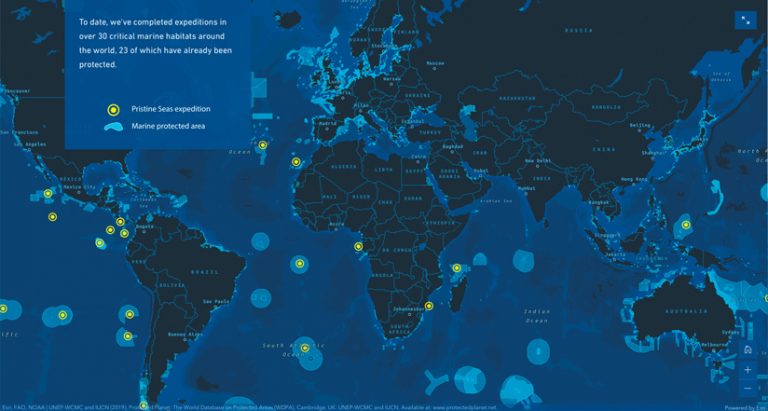
Today Sala is working toward that cure. He is the founder and leader of the National Geographic Society Pristine Seas project, which is dedicated to saving a minimum of 30 percent of the world’s oceans by 2030. His team of scientists, filmmakers, conservationists, and policy experts explore what Sala calls “the last wild places in the ocean.” The research the team members conduct and the films they make help build cases for the creation of marine protected areas (MPAs). They collaborate with nonprofit organizations, communities, and governments to preserve the areas.
According to the National Geographic Society, the Pristine Seas project has helped establish 23 of the largest marine reserves on the planet, covering an area of 6.5 million square kilometers.
MPAs ban activities that are harmful to marine life, including fishing. In the long run, said Sala, this can actually provide sustainable benefits to commercial fishing. He told the story of a small marine reserve created 20 years ago off the Baja, California, coast with support from the fishing community. The area was overfished, so the community stopped fishing there temporarily. What Sala described as an “underwater desert” in 1999 was teeming with fish, including large predators, a decade later.
“You know who else is thriving? Those visionary [fishers],” he said. “They are making far more money now from tourism inside the reserve—diving tourism—and from fishing around it.”
Less than 3 percent of the world’s oceans are fully protected from fishing and other harmful activities, according to Sala. To determine how much of the planet’s oceans need protection and the areas to prioritize, Sala and his team are using a scientific approach that includes the use of GIS.
The Pristine Seas team, for example, wanted to know which areas of the ocean contained unique and irreplaceable marine life that is threatened by fishing or other human activities. The team launched a scientific study three years ago to determine which areas of the ocean must be protected first based on a number of variables, such as the risk of extinction. GIS technology was used to map data that helped reveal the highest-priority areas. The team also created a map to rank areas that, if protected, would ultimately benefit fisheries outside the MPAs.
“If we protected the right areas in the ocean, these areas could provide an extra 10 million fish and invertebrates for us to eat,” Sala said.
Pristine Seas used Esri technology to build a web app that ranks priority areas based on biodiversity protection, food production, and carbon storage to mitigate climate change. According to Sala, this tool will inform government officials’ and other stakeholders’ decision-making.
“We will be able to help countries not only be reassured that protection is going to benefit the fisheries and help reduce carbon emissions, but they will also know this tool will help them implement that commitment,” he said.
The Concrete Realities of Climate Change and Inequality
While Sala’s eyes focus on the world’s oceans and marine life, Salopek keeps close watch on the land and its people.
Salopek founded and is leading the Out of Eden Walk, a National Geographic Society project to retrace the ancient path of global migration. Salopek is doing this by walking 24,000 miles from Ethiopia to the southern tip of South America, chronicling his journey along the way with articles published in National Geographic and other publications, as well as through stories created using ArcGIS StoryMaps.
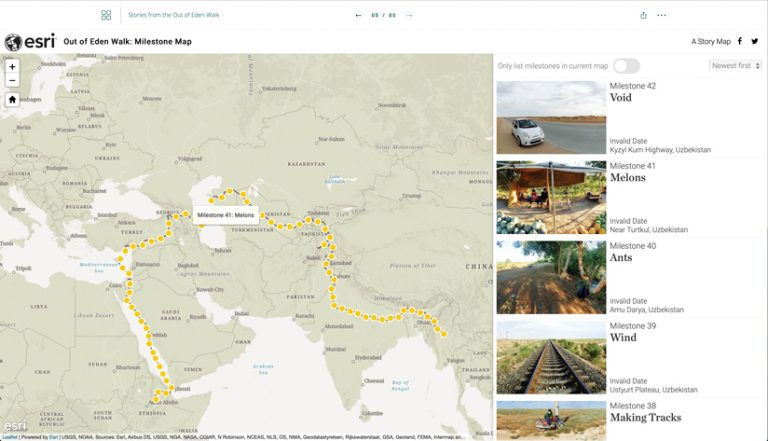
Salopek began the Out of Eden Walk in 2013 and is currently in China. He expects to finish the walk in about seven years.
In his Esri UC talk, Salopek said he confronts sustainability issues, from climate change to income inequality, all the time.
“It’s concrete. It’s not abstract,” he said.
The impact of climate change was glaringly apparent when Salopek joined Afar pastoralists as they herded camels in East Africa’s Great Rift Valley.
“Fickle rains are getting more unpredictable. Pastureland is shriveling up. Water holes are drying out,” he said. “[The Afar people’s] entire way of being—this pastoral economy of moving animals across an unreliable landscape—is becoming increasingly untenable and pushing them into cities. A whole way of life is thinning out and vanishing.”
In India, Salopek said he witnessed the negative impact of the country’s green revolution that boosted crop production in part by using fossil fuels to pump groundwater. Now the nation is plagued by water pollution and a lack of water.
“India is going through the most severe water crisis of any country in the world,” he said. “They are not just running out of water to drink but [also] water to grow their foods and to stoke their industries. [And] now water quality is highly compromised by pesticides [and] by chemicals.”
Though the problem is overwhelming, local communities are responding to increase sustainability.
“[People] were digging tens of thousands of small surface wells to capture rainfall,” Salopek said. “They were [planting] old crops that were better adapted to drought conditions to feed themselves.”
Salopek left the virtual audience with words of wisdom about the importance of sharing resources, embracing openness, and seeking solutions.
“We are an amazing problem-solving species,” he said. “We have lots of problems—most of them created by ourselves—and we have to resolve them. But our ancestors—the ones who walked across the earth back in the Pleistocene [epoch] and those hunters and gatherers whom I’m following from campfire to campfire—they problem solved their way across unknown landscapes. We’ve got to continue using those muscles.”
Equity as a Path Toward Sustainability
Promoting equity is an important part of creating a sustainable future, according to Dangermond. He invited Montgomery Tabron to talk about this topic in front of the global Esri UC audience.
Her organization, WKKF, awards grants to support the health, welfare, and education of children; assist families; and build equitable communities. The foundation, launched by Kellogg Company founder William Keith Kellogg in 1930, awarded $252 million in grants in the fiscal year that ended in August 2020.
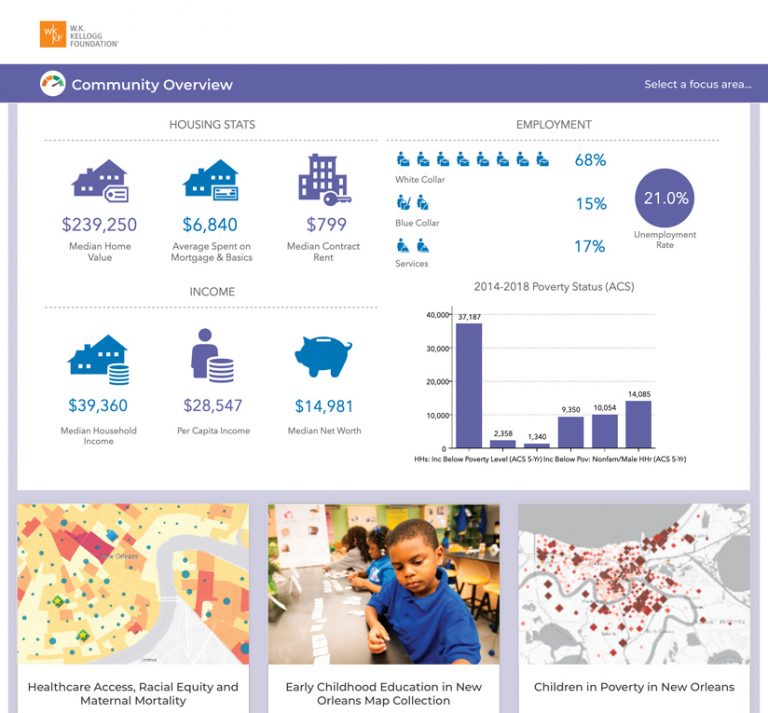
“[Kellogg] gave us, as a north star, [a mission to] create a place where all children can thrive,” Montgomery Tabron said. “To make sure that children thrive, you must look at issues of racial equity, community engagement, and leadership.”
GIS technology can be used to better understand systems and structures that create these issues, according to Montgomery Tabron.
“By mapping data on COVID-19, for example, you start to see, as we did, that people of color were having more complications as it related to COVID-19 and were even maybe dying more than others,” she said. “That allowed us to [ask], What are the systems that are producing these outcomes? And we learned that more people of color were essential workers who couldn’t stay inside their homes and quarantine. Therefore, they were exposed [to the disease] by greater measures.”
WKKF, its grantee the PVBLIC Foundation, Esri, and the United Nations have developed a partnership called the SDG Data Alliance in support of the United Nations’ Sustainable Development Goals (SDGs), including goal 10: reduced inequalities.
“This alliance will enable 20 countries in Africa, Latin America, and the Caribbean to achieve the Sustainable Development Goals,” Montgomery Tabron said, adding that many of these nations face practical and technological barriers to working on the goals. “The grant will build the information technology capacity and infrastructure to allow these countries to monitor and report their efforts toward achieving the goals.”
WKKF is partnering also with the Southern Communities Initiative to create an action plan to tackle issues related to equity in communities such as Atlanta, Georgia; Birmingham, Alabama; Memphis, Tennessee; Houston, Texas; New Orleans, Louisiana; and Charlotte, North Carolina. One aspect of the project is the production of community action hubs, where data and maps on wealth creation, jobs, education, health, and housing can be accessed to promote better-informed decision-making by government officials, business leaders, and others. To see an example of a community action hub, visit the New Orleans Community Action Hub.
“We hope the GIS community will help us realize this vision,” Montgomery Tabron said. “We have the tools. We want the GIS community to stand up these community action hubs all over the nation.”
Taking Collective Responsibility for the Future
Dangermond praised the work of Crowfoot, Sala, Salopek, and Montgomery Tabron and their organizations for the leadership roles they are taking in creating a sustainable future. He then encouraged everyone to get involved.
“Our world is being challenged on many fronts, and we will increasingly need to be responsible for its future,” Dangermond said.
He pressed audience members to move forward with purpose, doing things such as providing leadership, thinking geographically and holistically, applying new tools and methods, and collaborating and exchanging ideas with other organizations. Now is the time to act, he said.
“These are the times we are going to have to get it together and move at many different scales,” Dangermond concluded.
